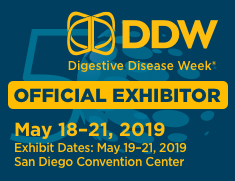EGS to host DDW Product Theater session showcasing the evolution of TIF 2.0 procedure along with updates on concomitant hiatal hernia repair
 REDMOND, Wash. – EndoGastric Solutions® today announced that new data on the Transoral Incisionless Fundoplication (TIF® 2.0) procedure will be presented during multiple sessions at Digestive Disease Week® (DDW®) 2019. These data add to the robust set of published studies demonstrating the effectiveness of the TIF 2.0 procedure performed with or without laparoscopic hiatal hernia repair in treating gastroesophageal reflux disease (GERD). DDW, the world’s largest gathering of physicians, researchers and industry leaders in the fields of gastroenterology, hepatology, endoscopy and gastrointestinal surgery, takes place in San Diego, May 18 – 21, 2019.
REDMOND, Wash. – EndoGastric Solutions® today announced that new data on the Transoral Incisionless Fundoplication (TIF® 2.0) procedure will be presented during multiple sessions at Digestive Disease Week® (DDW®) 2019. These data add to the robust set of published studies demonstrating the effectiveness of the TIF 2.0 procedure performed with or without laparoscopic hiatal hernia repair in treating gastroesophageal reflux disease (GERD). DDW, the world’s largest gathering of physicians, researchers and industry leaders in the fields of gastroenterology, hepatology, endoscopy and gastrointestinal surgery, takes place in San Diego, May 18 – 21, 2019.
“TIF 2.0 addresses an unmet clinical need for patients suffering from GERD. The ability to perform TIF 2.0 safely with concomitant laparoscopic hiatal hernia repair increases the number of patients who now can achieve long-term relief of their GERD symptoms.” – Skip Baldino, President and CEO of EndoGastric Solutions
“We are pleased to have multiple opportunities to share incremental clinical findings underscoring the efficacy of TIF 2.0 and the high level of patient satisfaction for the TIF 2.0 procedure,” said Skip Baldino, President and CEO of EndoGastric Solutions. “TIF 2.0 addresses an unmet clinical need for patients suffering from GERD. The ability to perform TIF 2.0 safely with concomitant laparoscopic hiatal hernia repair increases the number of patients who now can achieve long-term relief of their GERD symptoms.”
The TIF 2.0 procedure is a minimally invasive endoscopic intervention performed with the EsophyX® device, which enables anatomical correction of the gastroesophageal valve without the resulting complications associated with traditional fundoplication. This approach provides an effective treatment option for patients seeking an alternative to traditional, more invasive surgical treatment options. For patients with hiatal defects of two centimeters or more, new data reiterate the conclusion that a concomitant hiatal hernia repair and TIF 2.0 procedure improves objective and subjective assessment of GERD symptoms.[i]
The TIF 2.0 procedure will be featured in the following sessions at DDW 2019:[ii]
Podium Presentation – New Technology Endoscopic Advancements Session
719: Efficacy and Patient Satisfaction of Single-Session Intraoperative Transoral Incisionless Fundoplication and Laparoscopic Hernia Repair (ASGE). Monday, May 20, 3:00 p.m. – 3:15 p.m., Room 6C. Presented by: Viktor E. Eysselein, MD, Harbor UCLA Medical Foundation, California.
Poster Presentation – New Technology Session
Tu2020: Transoral Incisionless Fundoplication: Effectiveness in Improving Typical and Atypical Symptoms of Gastroesophageal Reflux Disease Incompletely Controlled with Medical Therapy (ASGE). Tuesday, May 21, 12:00 p.m. – 2:00 p.m., Halls C-E. Presented by Amit Sohagia, MD, Easton Hospital, Pennsylvania.
DDW Product Theater – Shaping the Future of GERD
EndoGastric Solutions is sponsoring a symposium at DDW 2019 titled “Shaping the Future of GERD” from 11:30 a.m. to 12:05 p.m. on Sunday, May 19, in the DDW Product Theater 1. During this session, faculty will present an overview of data surrounding the evolution of the TIF 2.0 procedure, including pH control, concomitant use following hiatal hernia repair, and endoscopic treatment of foregut diseases. Faculty members include:
- Barham Abu Dayyeh, MD, MPH, FASGE, Mayo Clinic, Rochester, Minnesota
- Glenn Ihde, MD, Matagorda Medical Group, Bay City, Texas
- Kenneth Chang, MD, FACG, FASGE, UCI School of Medicine, Irvine, California
The American Society for Gastrointestinal Endoscopy (ASGE) Special Interest Group Meeting
Endoluminal Therapy for Esophageal Disease and Gastroesophageal Reflux Disease (ETED/GERD SIG) will be held during DDW on Monday, May 20, from 10 a.m. to 11:30 a.m. in Ballroom B. During the session, faculty will review endoscopic options for patients with esophageal motility disorders, GERD, Barrett’s esophagus and esophageal cancer.
